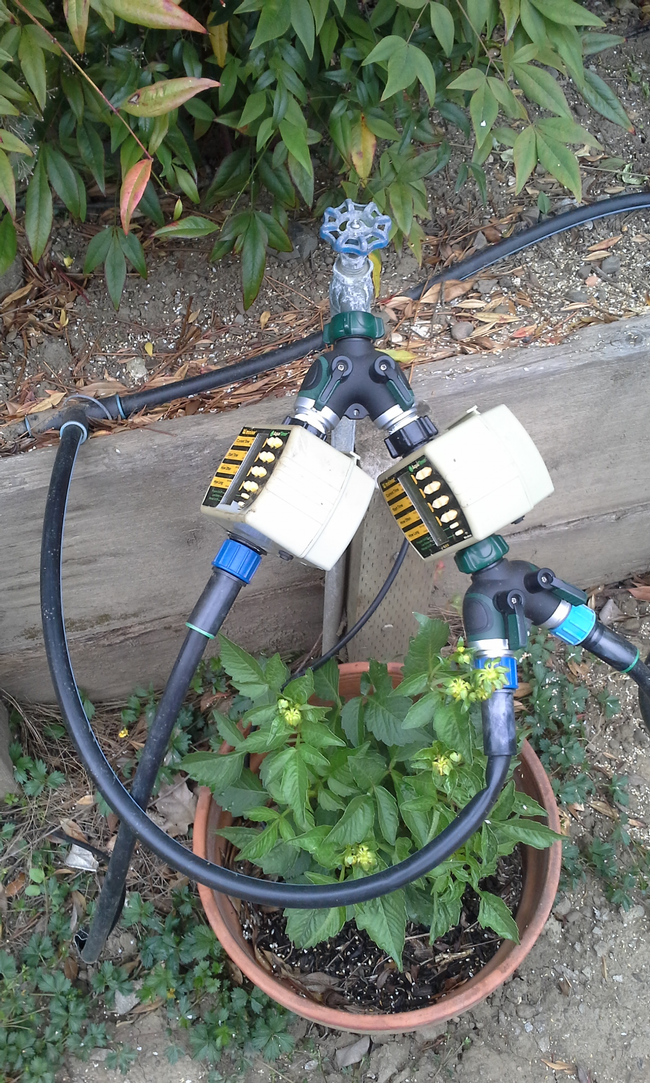
Fast forward to today. California is experiencing a drought and has been for the last few years. Thanks to my parents, I'm ready.
A drip system is the way to go for frugal water use in the garden. I have learned many lessons over the years and had some failures, but mostly my drip-irrigation system has been a success. Although Mom and Dad provided the original supplies and plan, I have had to purchase additional components, which required a learning curve.
Not only are there different systems but some parts have become obsolete and hard to replace. The key to success is simplicity. Another tip: always purchase parts from the same place, or at least know what type of system you have and the diameter of your tubing.
I have attended several irrigation and drought workshops over the years. All of them involved computing water distribution, as in how many gallons per hour each plant needs. Usually my eyes roll back in my head at that point in the presentation. In a small home garden, you can just observe your plants: do they look stressed? If so, check the water distribution. It's either too much or not enough.
I have six stations in my system. Each station consists of a battery-operated timer at the hose bib and half-inch and quarter-inch black hose with micro-sprayers and drippers. I have tried to use only drippers on one line and sprayers on another as they have different pressure requirements, but I do have some systems with both.
Quarter-inch drip tubing with emitters at preset spacing is a great choice and easy to place. I have found that a perforated tube or soaker hose needs a designated line as the pressure in that line dips alarmingly when the soaker hose is in use.
The battery-operated timers are a good option for me because no hard wiring is required. They do have to be protected from the weather. I usually wrap them in clear,sealable plastic bags to allow for easy viewing and to blend into the landscape.
To keep the system from totally commandeering the hose bib, I use a “Y” attachment with shut-off valves. That way, I can use the hose bib for other needs. I only use my drip system from May through October. When autumn rains begin, I disconnect the timers, remove the batteries and store them for the winter.
Keep operating manuals for the timers in a designated place. Many times I have tried to get my system up and running in the spring and can't remember how the timer works.
In early May I set up all the systems for the summer. No matter how much I check first, I always manage to be standing directly on top of a broken sprayer when I turn the system on to test it. The upside is that I have yet to miss a broken sprayer.
I have had some problems with the system over the years, but to be honest, they were mostly operator errors. With much colorful language, I have cut through irrigation lines while digging up beds. Good news: that's an easy fix.
One year I noticed the pressure at the end of one of my systems was non-existent. Upon further investigation, I discovered a buried portion of the system had become disconnected. Not an easy fix.
I had to dig down at least two feet to get to the connection. Note to self: don't bury lines. Just fluff some soil over the lines if an exposed hose disturbs your sensibilities.
Last month, I had to turn off the water to the house because of a plumbing problem. I forgot about it until the next morning, when the first line came on. The tip of a micro-sprayer flew up in the air and went who-knows-where. To avoid this excitement, make sure to “bleed” the lines: with water turned off,detach the system from the hose bib, then turn on the water to release pressure and allow air to escape. Re-attach and you're ready to go.
Upcoming event: The Napa County Master Gardeners'“Down the Garden Path” Garden Tour is Sunday, September 13.The second garden on the tour is the proud recipient of a new drip system. At that site, you can peruse a reference binder with step-by-step instructions for installing drip irrigation.Click http://bit.ly/1fqLJZe for information and tickets.
Workshops: Napa County Master Gardeners will host a workshop on “Good Garden Resources in Print & Tech” on Saturday, July 11, from 9:30 a.m. to 11:30 a.m., at the University of California Cooperative Extension office, 1710 Soscol Avenue, Napa. Who do you trust for dependable gardening information? Where do you look for answers to your horticulture questions? Participants are invited to bring tablets or laptops. Master Gardeners will help you evaluate sources of gardening information, both online and in print. Online registration (credit card only);Mail-in registration (cash or check only).
Napa County Master Gardener will also host a workshop on “Dealing with Drought and Drought-Tolerant Plants” on Saturday, July 11, from 10 a.m. to noon, at Mid-City Nursery, 3635 Broadway, American Canyon. Learn what to do now to help your garden survive on very little water. We will discuss what kinds of plants do best with minimal water. Learn about easy-care, long-flowering, colorful plants for your garden and ones that will attract pollinators. We will also discuss fire-wise plants and gardens. Online registration;Mail-in registration.
Master Gardeners are volunteers who help the University of California reach the gardening public with home gardening information. Napa County Master Gardeners ( http://ucanr.org/ucmgnapa/) are available to answer gardening questions in person or by phone, Monday, Wednesday and Friday, 9 a.m. to Noon, at the U. C. Cooperative Extension office, 1710 Soscol Avenue, Suite 4, Napa, 707-253-4143, or from outside City of Napa toll-free at 877-279-3065. Or e-mail your garden questions by following the guidelines on our web site. Click on Napa, then on Have Garden Questions? Find us on Facebook under UC Master Gardeners of Napa County.